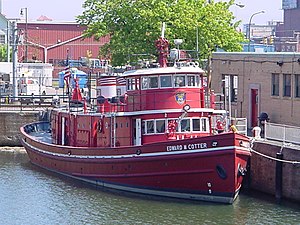Edward M. Cotter (fireboat)

Edward M. Cotter berthed.
|
|
| History | |
|---|---|
|
|
|
| Name: | William S. Grattan (Engine 20) |
| Operator: | Buffalo Fire Department |
| Builder: | Crescent Shipbuilding of Elizabeth City, New Jersey |
| Cost: | $91,000 |
| Laid down: | March 24, 1900 |
| Sponsored by: | Virginia Pearson |
| Christened: | September 5, 1900 by Virginia Pearson |
| Renamed: |
|
| Refit: |
|
| General characteristics | |
| Type: | Fireboat |
| Tonnage: |
|
| Length: | 118 ft (36 m) |
| Beam: | 24 ft (7.3 m) |
| Draft: | 10 ft 10 in (3.30 m) |
| Ice class: | 1.5 in (38.1 mm) thick belt line of Swedish steel around the icebreaking part of the hull |
| Installed power: |
|
| Propulsion: |
|
| Speed: |
|
| Capacity: | |
| Notes: |
|
|
Edward M. Cotter
|
|
 |
|
| Location | Buffalo, New York |
| Built | 1900 |
| Architect | Crescent Shipbuilding Co. |
| NRHP Reference # | 96000968 |
| Significant dates | |
| Added to NRHP | June 28, 1996 |
| Designated NHL | June 28, 1996 |
Edward M. Cotter is a fireboat in use by the Buffalo Fire Department at Buffalo, New York, United States. Originally named William S. Grattan, she was built in 1900 by the Crescent Shipyard of Elizabeth Port, New Jersey. Due to age she was rebuilt in 1953 and renamed Firefighter upon her return to service. The following year she was renamed Edward M. Cotter. Her namesake, Edward Cotter, was a Buffalo firefighter and leader of the local firefighters union who had recently died.
Edward M. Cotter is considered to be the oldest active fireboat in the world and was designated a National Historic Landmark in 1996.
Along with her firefighting duties, during the winter Edward M. Cotter is used as an icebreaker on Buffalo's rivers. Edward M. Cotter mounts five fire monitors that are capable of pumping 15,000 US gallons per minute (0.95 m3/s; 12,000 imp gal/min). She can often be seen sailing out of her berth and south-west to Lake Erie, returning north through the breakwall and firing her fire monitors.
The ship that was to become Edward M. Cotter was built in 1900 by the Crescent Shipyard of Elizabeth Port, New Jersey. She was originally named William S. Grattan after the first paid fire commissioner for the city of Buffalo. Construction was started on March 24, 1900 and she was christened on September 5, 1900 by Virginia Pearson, the young daughter of one of the city's fire commissioners. The final construction cost for the ship was $91,000.
The completed ship was 118 ft (36 m) in length, had a beam of 24 ft (7.3 m), and drew 10 ft 10 in (3.30 m). A 1.5 in (38.1 mm)-thick belt-line of Swedish steel was included around the hull for icebreaking duties. William S. Grattan was powered by two Babcock & Wilcox coal-fired boilers with steam engines rated at 900 horsepower (670 kW). A single propeller provided propulsion. The rated speed of the ship was 13 knots (24 km/h; 15 mph).
...
Wikipedia
